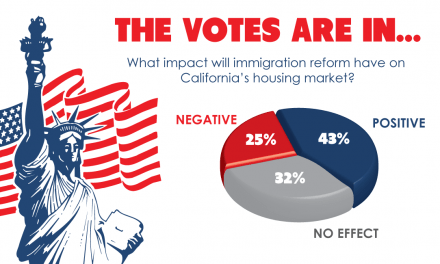After a solid recovery boom, confidence about future growth in the national commercial real estate market is dwindling. Forecasters now predict income property prices and developments to stagnate nationwide over the next few years.
For the California commercial real estate market, the UCLA Anderson Forecast echoes similar expectations with some optimistic variance: while office and retail construction is expected to run at a slower pace over the next three years, confidence remains high for industrial and multifamily housing developments.
These commercial real estate forecasts follow a period of strong, continued growth in commercial real estate — both nationwide and in California. Present lower vacancy rates and elevated prices now buoying the market will encourage cities to permit more development and, with some time to forget, accelerate lender funding of projects.
Commercial forecasts and trends
In California, a closer look at each region is required to track income property construction activity. UCLA’s commercial forecast, based on a survey of leading real estate developers in the state, evaluates expectations in seven major California regions:
- Los Angeles;
- Inland Empire;
- Orange County;
- San Diego;
- East Bay;
- San Francisco; and
- Silicon Valley.
Their June 2016 survey reveals a recent apprehension among commercial real estate forecasters. Though developer outlooks remain mostly positive, confidence has waned across all regions and in most commercial sectors since December 2015.

Source: UCLA Anderson Forecast
Developers expressed less optimism about office, retail and industrial growth, with negative outlooks emerging for office developments in East Bay, San Francisco and Silicon Valley. Meanwhile, the outlook remained positive for multifamily developments in Los Angeles, Orange County and San Diego as job growth and high demand for rentals is expected to spur multifamily construction.
Further, though expectations for industrial growth declined overall, the outlook still trended higher than office and retail across all regions. Expectations for retail are lowest throughout Southern California, the result of a shifting demand from brick-and-mortar retail to online sales. However, e-commerce growth has heightened the need for warehousing, increasing industrial developments close to all population centers.
A more detailed assessment of Southern California’s income property market reveals similar regional trends across commercial sectors in the second quarter (Q2) of 2016. Some key points to glean from the data:
- industrial real estate is growing at a rapid pace in the Inland Empire, while the office market is struggling with high vacancy rates and little new construction for lack of a highly educated and skilled population;
- Los Angeles is experiencing strong industrial growth — where the lowest vacancy rates were seen — and a steady office sector;
- Orange County’s industrial sector is headed for expansion with development of large industrial buildings driven by low vacancy rates, and low office vacancy rates fueling expectations for gradual growth; and
- industrial development is increasing in San Diego, but vacancies remain high for offices, and low vacancy rates for retail are expected to drive rental rates up and eventually spur retail construction.
What’s driving commercial real estate trends?
While forecasters nationwide and in California expect commercial real estate growth to slow, rental rates and prices are not expected to slip in urban areas. Despite the challenges of zoning restrictions limiting the use of property, Generation Y’s migration to city centers due to strong job markets in populated urban regions have fueled all varieties of developments.
The resulting expansion has some questioning whether this rapid growth now signals the presence of a commercial real estate bubble ready to pop. But fear not: this bubble will not pop with disastrous economic consequences. It will merely deflate as councils ease zoning, lenders see construction opportunities and market demand shifts again.
In California, the two types of construction projects at the center of commercial growth are industrial and multifamily.
The contemporary rise in retail e-commerce is dampening the development of retail buildings in this recovery. Taking its place is industrial construction for warehousing and distribution to support online retailers — Amazon is a prime example, having just signed their ninth lease in California.
Industrial development is taking hold most prominently in the Inland Empire. Its availability of low cost land, lower rental rates, access to a large population of consumers and close proximity to ports like Los Angeles and Long Beach (and several retired air force bases) make it a desirable location — a case of supply meeting demand at an increasing pace.
Nonetheless, opportunities still remain in brick-and-mortar retail to support consumer populations, especially near multifamily developments. Los Angeles developers, in particular, have jumped at this opportunity by increasing mixed-use construction.
Meanwhile, housing demand in high-density regions and Gen Y’s stalled homeownership is driving multifamily construction. As job growth heightens housing demand — especially in urban centers — California is expected to experience an extended period of increased multifamily construction with low vacancy rates in San Diego, Silicon Valley and San Francisco. At some point in the foreseeable future, today’s younger households will shift from renting to owning a single family residence (SFR) for shelter, leaving vacant apartments behind.
Some forecasters predict Los Angeles will not experience low vacancies, as ever rising rental rates allow landlords to endure more vacancies, due to the option value presented in future higher rents for setting property prices for resale.
In any case, California’s rapid household formation, job growth and rental demand will continue to spur multifamily developments across the state for several years to come. For developers, investors and mortgage lenders, the construction vacuum created by high levels of demand will keep income-producing real estate on an accelerating path of expansion — until our inevitable Minsky Moment for commercial property when absorption rates suddenly disappear and we again wonder why.



















